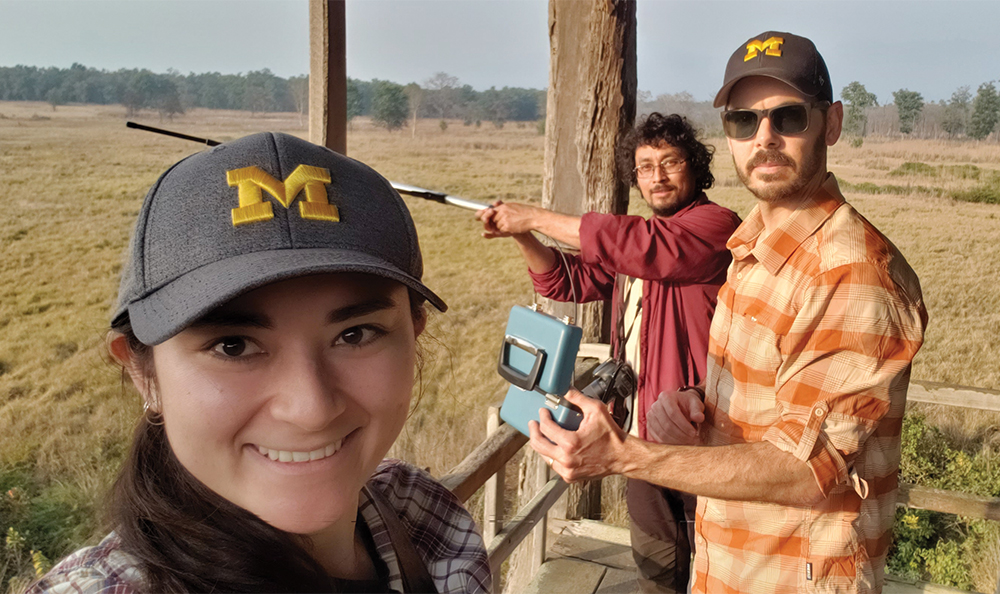
Fostering Human-Tiger Coexistence in Nepal
SEAS PhD student and wildlife researcher Amy Zuckerwise has studied ocelots in Bolivia and bobcats in California. But even she was amazed at how thrilling it was to see Bengal tigers up close in the wild when she visited Nepal last spring.
“When you see a tiger, everything immediately stops, and everything becomes hushed,” Zuckerwise says. “I got lucky and saw three tigers, when many people never get a chance to see even one, so it was pretty incredible.”
These majestic creatures were the reason Zuckerwise traveled more than 7,400 miles to the Terai Arc Landscape, an area in southern Nepal filled with forests, grasslands, rivers and agricultural lands that are shared by more than 13 million people and home to endangered species, including greater one-horned rhinos, Asian elephants and Bengal tigers. Taken during the Year of the Tiger, it was the first of several research trips Zuckerwise plans to take in support of her dissertation, which focuses on the impacts of road development on tiger populations.

Tracking Tigers
Zuckerwise is building on the research that her adviser, SEAS Associate Professor Neil Carter, began two years ago when he visited the Terai to partner with the Nepal Department of National Parks and Wildlife Conservation, the National Trust for Nature Conservation and the International Union for the Conservation of Nature in Nepal to place GPS collars on tigers living near roads.
Nepal, one of the least-developed nations in the world, is undergoing rapid road and infrastructure development aimed at connecting remote villages and fostering economic growth. Zuckerwise says there is concern about how this transportation development may affect tigers, whose numbers have almost tripled to 355 since 2009 thanks to conservation efforts.
The collars, while inconspicuous to the animals so as not to impact their behavior, connect to GPS satellites at least 16 times a day, and can capture real-time data about tiger movement, such as how tigers move along roads before and after crossing; where and how they hunt near roads; and how they respond to vehicle traffic.
“The GPS collars can give us detailed information about tigers that we can’t get any other way,” Zuckerwise says. “Combining that technology with the perspectives of Nepali people who live with tigers in their landscape will give us new insights about how to balance the needs of people and economic development with ongoing wildlife conservation efforts.”
“When you see a tiger, everything immediately stops, and everything becomes hushed.”
Zuckerwise had hoped that a collar could be placed on at least one tiger during her visit, but none ventured close enough to the survey area. She and her team also wanted to retrieve a collar that had dropped off a previously collared tiger, but they were not able to find it.

“That’s the nature of fieldwork,” Zuckerwise says, noting that the trip was beneficial in other ways. Not only was it “amazing” to see “big and healthy” tigers thriving in their natural habitat, but the trip also enabled Zuckerwise to learn more about the history of Nepal and the cultural significance of tigers, as well as meet her Nepali colleagues in person after spending the past year connecting with them via Zoom. “It was really important for me to show up for our Nepali collaborators and put into action the research that I’m doing,” Zuckerwise notes. “The point of doing a conservation project in their country is to partner with them to develop solutions that will help them better coexist with tigers.”
A Passion for Feline Conservation
Zuckerwise, who was born and raised in Los Angeles, has had a lifelong love of cats, both domestic and wild. After earning her undergraduate degree from Stanford University, where she studied bobcats, she completed a master’s degree at the Yale School of the Environment, which led to ocelot research in the Amazon rainforest of Bolivia.
When Zuckerwise, who was working as an environmental scientist for the California Department of Fish and Wildlife Bobcat Program, learned about the opportunity to study tigers with Carter, she says she jumped at the chance to apply, as she knew it was the “perfect project” for her to continue her passion for feline conservation.
While preparing for a second trip to Nepal this winter, Zuckerwise has been analyzing preliminary data taken from the two tigers that were collared during Carter’s original trip in 2021. The information suggests that the tigers, who are located near the East-West Highway, are influenced by how much traffic is on the road, Zuckerwise says. The tigers seem to avoid crossing the road in high-traffic areas but cross the road more frequently in low-traffic areas.
This information, Zuckerwise notes, can help inform ways to make roads more tiger-friendly, such as by implementing speed limits or wildlife crossing signs or realigning roads away from tiger habitats.

